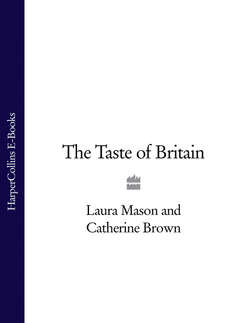Читать книгу The Taste of Britain - Hugh Fearnley-Whittingstall - Страница 269
HISTORY:
ОглавлениеEarliest references to barley wine by name date from the twentieth century (OED). Jackson (1993) considers, ‘the romantic term “barley wine” may have been coined by rural home-brewers to describe their most impressively potent efforts’. There is no evidence that the name came from the use of wine yeasts. It is now often employed by brewers to describe their strongest ale, but the style is older than the name. It is kin to the dark beers known earlier as porter. The archaic northern dialect word ‘stingo’ has also been used. In Scotland, such powerful beers are known as ‘wee heavy’.
Dorchester developed as a centre of the brewing industry during the eighteenth century, due partly to a chalk aquifer in the strata below the town. Richard Bradley (1736) wrote of its fine beer with ‘a strength of malt and hops in it’ to last 4 years. ‘[It] is esteem’d prefereable to most of the Malt-Liquor in England,’ he continued, ‘[for] it is for the most part brew’d of chalky water.’
Hardy himself wrote a lyrical description of Dorchester ale in The Trumpet Major (1880). The drink which now bears his name, however, is recent: developed in 1968 to honour the then prime minister, Harold Macmillan, whose family was Hardy’s publisher. Breweries who produce barley wines often give them names of characters, fictional or real. Eldridge Pope, the brewers of this beer, were founded in 1837.
When I got my first job on a newspaper it was as cookery writer for the Daily Mail, and I was lucky not to lose it in the first month. I had written a recipe for Oxford Marmalade - you know the one: made with bitter Seville oranges, chunky and dark with treacle - but I had written it by hand and forgotten to cross the ‘t’ in treacle. This meant that ‘2 tbs’ was printed as ‘2 lbs’. Since the rest of the ingredients only amounted to ten oranges and a kilo of sugar, this had disaster potential. And a disaster it was.
You would not believe the number of people who just accept what they read in newspapers. The Daily Mail switchboard went white-hot with complaints about the black caramel in readers’ saucepans. We had to reimburse readers for a lot of ingredient costs and quite a few saucepans which were damaged beyond repair. So when a woman rang up and suggested we let her know how much extra sugar and how many extra oranges she should add to the mixture to get the proportions right again, I thought, ‘Good, this is how we rescue the situation - we just get everyone to make extra marmalade for next year, plus a few pots for the village fête and so on.’ Until, that is, we worked out that each reader would need to make about eighty jars of marmalade. We reimbursed her like everyone else.
The day after publication I found what looked like a letter bomb on my desk. Well, I knew I’d got the recipe wrong, but I thought bombing was going a bit far. I could tell it was a bomb because, this being the time of the IRA letter bomb campaign, we’d all had bomb training. If you got a suspicious package, especially one like this, which had something squashy in the middle and what felt like wires sticking out each side, you called the security desk and they sent a copper in a flak jacket who took it away.
Eventually the copper brought it back. It contained a piece of marmalade toffee with a dental brace, complete with two teeth embedded in it. And a very large orthodontist’s bill.
Prue Leith
COOKERY EDITOR, FOOD COLUMNIST AND BROADCASTER,
AND FOUNDER OF LEITH’S RESTAURANT
